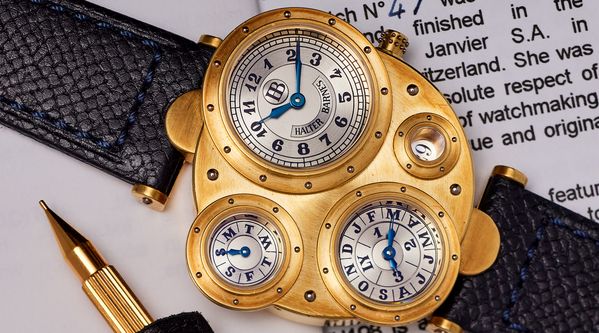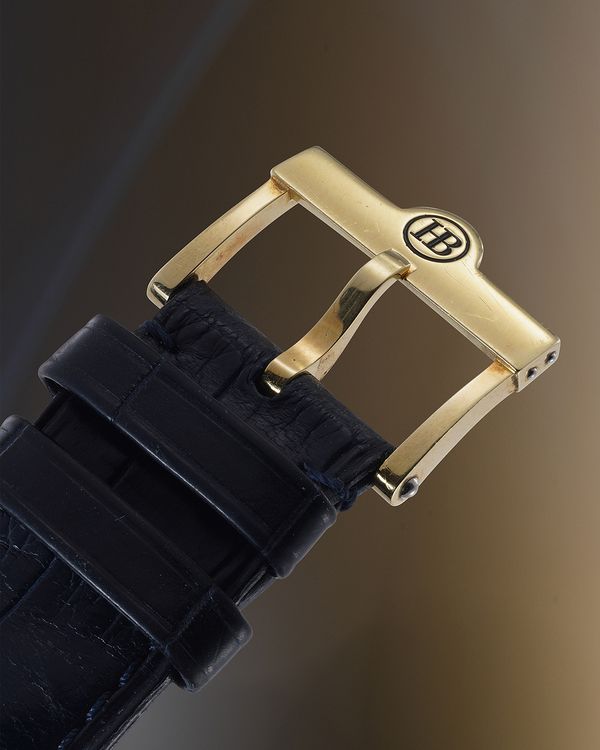The New York Watch Auction: EIGHT takes place on June 10 and 11, inside our Manhattan headquarters at 432 Park Avenue. The auction includes more than 120 of the world's finest watches; here, we look into the volatile relationship between French watchmaker Vianney Halter and American designer Jeff Barnes as well as highlight a fresh-to-market Halter Barnes Antiqua, the earliest known example, included in our New York sale.
– By Logan Baker
The Antiqua is one of the most influential watches to emerge from the renaissance of independent watchmaking in the late 1990s. It was one of the first modern wristwatches to break the confines of traditional aesthetics, embracing a steampunk-adjacent design. It came before the current generation of experimental watchmakers, such as MB&F, De Bethune, and Richard Mille and no doubt influenced a few of them in certain ways.
The Antiqua is famously a Vianney Halter creation, a product of the eccentric French watchmaker’s workshop in Sainte-Croix, Switzerland. But what if I told you that Halter had a partner in the Antiqua’s development? A person that was so significant to the process that early Antiqua examples featured two different names signed on the dial rather than Halter by himself.
The story of the partnership between Vianney Halter and American designer Jeff Barnes has been little explored over the years, but it’s an important part in understanding Halter’s career and watchmaking journey. It’s also rife with drama, tension, and plenty of “He Said, She Said” moments.
This mostly forgotten chapter has been revived thanks to the discovery of lot 47 in the New York Watch Auction: EIGHT. A fresh-to-market Antiqua in 18k yellow gold bearing the “Halter Barnes” name was consigned by its original owner. It’s the earliest Antiqua ever seen publicly, and it’s only the second one with a Halter Barnes signature to appear at auction, making it likely the most important Antiqua example to ever hit the rostrum.
Here’s everything you should know about the Antiqua and the volatile relationship between Halter and Barnes.
An Auspicious Beginning
Jeff Barnes is a Chicago-based artist and graphic designer whose work is included in the permanent collections of the Library of Congress, the Cooper-Hewitt Museum, and the Museum of Modern Art in New York. He had been interested in watches for much of his life, and he began sketching out unique and unusual watch designs in the 1990s.
With the help of a Chicago watch distributor, Barnes eventually approached Vianney Halter with his designs to see if they could possibly be made and if Halter was potentially interested in partnering to produce them. Halter, who had left Techniques Horlogères Appliquées (THA) to open his own workshop in 1994, agreed to the collaboration – and thus, “Halter Barnes” was born.
Three of Barnes’ designs would eventually take shape in Halter Barnes and Vianney Halter watches: the Antiqua, the Classic, and the Trio. All three of those watches utilized a design language described by the pair as “Futur Antérieur,” or “Past Future,” or the concept of looking into the future through a historic lens.
Birth Of The Antiqua
Originally named “Time Machine Perpetual Futura” by Barnes, the Antiqua was the first of the three creations to be born. Barnes initially came up with the idea of the watch but the first illustrated concept was brought to life by Chicago visual artist Chris Sheban, on a commission from Barnes. It was Halter, however, who came up with the idea of incorporating a perpetual calendar into the watch.
The Antiqua was the most ambitious and complex watch to result from the Halter and Barnes partnership, featuring an elaborate precious-metal case construction and a self-winding integrated perpetual calendar movement that’s built around a reworked Lemania caliber 8810 with 60 to 70 percent of the original components replaced. The movement is completely visible through an exhibition caseback thanks to the use of a so-called “mystery rotor” made of sapphire crystal with a weighted oscillating mass hidden behind a peripheral ring – an attribute that would later become a signature element of Vianney Halter’s work. Barnes, however, has claimed it as one of his designs.
One particularly impressive detail of the Antiqua movement is its architecture. The double-barrel Lemania ébauche uses two large bridges that visually appear as a single one. In a clever move, Halter hid the small gap between the two bridges by following the natural pattern of the Côtes de Genève decoration. Another impressive attribute is the application of an instantaneous day and date change for the perpetual calendar.
The porthole-inspired case incorporated four separate circular windows housing the individual perpetual calendar displays and that protrude out from an oblong center area. Despite the appearance of an extra-large silhouette, the Antiqua is known for wearing remarkably well, with an approximate 40mm × 10mm case profile. A total of 104 white-gold rivets were hand-applied to each case, the crown alone featuring two rows of 12 rivets. Each of the dials is milled and engraved by hand out of either platinum or 18k white gold; the engraved numerals and markers were then filled with a black lacquer. Every dial contains multiple finishes and levels. The blued hands are also cut inside Halter's workshop.
It reportedly takes 900-odd hours of work to complete a single Antiqua – and the project appears to have been more difficult to get off the ground than either Barnes or Halter anticipated. According to an interview with Jeff Barnes published on TimeZone in October 2000, Barnes had to revise his original Antiqua case design after receiving an early prototype from Halter. Interestingly, while the watch was in this prototype phase, Barnes' sent his daughter, Maranda, to intern at Halter's studio.
A prototype was eventually presented during Baselworld 1998 as part of the booth dedicated to the Académie des Horlogers Créateurs Indépendants (AHCI), where Halter was a member. It reportedly took the encouragement of one Mr. Philippe Dufour who had caught wind of the project to convince Halter to display the watch that year.
Baselworld visitors that year had never seen anything quite like the Antiqua. The unexpected debut sparked countless discussions in the show halls – some instantly in love with the unique aesthetic, others scandalized beyond belief. However, all the sensation was good for sales, and the Halter Barnes order book quickly filled up.
The first few examples were delivered to clients and distributors the following year, including the watch featured in the New York Watch Auction: EIGHT. Conflict eventually broke out between Halter and Barnes around this time – which, according to Barnes’ TimeZone interview, was based around delivery timelines – and the pair eventually broke up.
Halter's Next Steps
Given the amount of time it took to complete each Antiqua, Halter had to take on work for other brands to keep his lights on. He eventually collaborated with Harry Winston, under the leadership of Max Büsser, on the Opus 3 (read our previous interview with Halter on the Opus 3 here). A funny story emerged when Ronald Winston, the son of Harry, went to visit Halter to see if he would be a right fit for the project – Halter impressed Winston so much that he ordered himself an Antiqua.
Halter continued to fulfill Antiqua orders, and he eventually introduced the Classic and the Trio under his own name, signing all his watches “Vianney Halter.” Meanwhile, it appears Barnes never worked in the watch industry again.
It’s not known how many “Halter Barnes”-signed Antiqua watches exist today. It’s believed that some early examples had their dials swapped during routine service to read “Vianney Halter,” and only one other Halter Barnes-signed Antiqua has previously appeared at auction; a third has sold via an online dealer.
Only 17 total examples of Vianney Halter's Perpetual Antiqua have come to auction, including the present lot, and only one previous example bearing “Halter Barnes” on the dial. Examples in yellow gold, white gold (1 piece), and pink gold (8 pieces), as well as platinum (3 pieces) have surfaced, with a total of only five examples in yellow gold.
The Halter Barnes Antiqua included in the New York Watch Auction: EIGHT bears the movement number "4Y" and is the earliest example to come to auction, and is accompanied by its original riveted porthole winding box, dated guarantee, instruction manual, and manufacture setting pin. It's lot 47 in the sale and carries an estimate of USD $120,000 - 240,000.
You can learn more about and register to bid in the New York Watch Auction: EIGHT by visiting our online catalog.
About Phillips In Association With Bacs & Russo
The team of specialists at PHILLIPS Watches is dedicated to an uncompromised approach to quality, transparency, and client service. Phillips in Association with Bacs & Russo holds the world record for the most successful watch auction, with its Geneva Watch Auction: XIV having realized $74.5 million in 2021. Over the course of 2021 and 2022, the company sold 100% of the watches offered, a first in the industry, resulting in the highest annual total in history across all the auction houses at $227 million.
About Logan Baker
Logan has spent the past decade working in watch-focused media, reporting on every aspect of the industry. He joined Phillips in Association with Bacs & Russo at the start of 2023 as the department's Senior Editorial Manager. He splits his time between New York and Geneva.
Recommended Reading
Revisiting The Opus 3, by Harry Winston And Vianney Halter
Sylvain Pinaud Had A Whirlwind 2022. It’s Just The Beginning Of His Journey.
Rexhep Rexhepi Reflects On The Original Chronomètre Contemporain, Five Years After Its Debut







